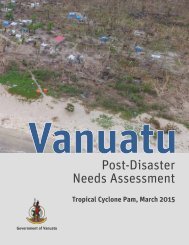Fiji
yqgk302EGjo
yqgk302EGjo
Create successful ePaper yourself
Turn your PDF publications into a flip-book with our unique Google optimized e-Paper software.
FIJI Post-Disaster Needs Assessment<br />
The disability baseline study “Making Women with<br />
Disabilities Visible” (2010) found that 89 percent<br />
of people with disabilities were unemployed,<br />
53 percent of whom were men and boys, while<br />
women and girls comprised the remaining 47<br />
percent.<br />
Population aged 15<br />
and over<br />
599,402<br />
The 2015 ILO Rapid Assessment on Child<br />
Labour in <strong>Fiji</strong> found that out of 186 working<br />
children interviewed, 50 percent were working in<br />
hazardous conditions in agriculture, construction,<br />
scrap metal collection, fishing and diving, in<br />
garages, and in illicit activities and commercial<br />
sexual exploitation.<br />
In the Labour force<br />
386,390<br />
64.5%<br />
Not in the Labour force<br />
213,013<br />
35.5%<br />
Poverty<br />
Poverty is a multifaceted issue in <strong>Fiji</strong> and while it<br />
can be seen and classified in many developing<br />
countries as extreme, poverty in <strong>Fiji</strong> is generally<br />
viewed as a hardship and instances of extreme<br />
poverty are very rare. This means that hardships in<br />
<strong>Fiji</strong> are generally related to lack of access to a fully<br />
nutritional diet, clean drinking water, improved<br />
sanitation, quality education and health care, and<br />
employment or income earning opportunities. 23<br />
The country’s strong community-based<br />
agricultural and fishing traditions and traditional<br />
safety nets allow for an individual to be cared for<br />
within the community. This makes those living in<br />
poverty in <strong>Fiji</strong> far better off relative to those living in<br />
extreme poverty in some other countries.<br />
Employed<br />
386,118<br />
95.3%<br />
Money Income<br />
273,354<br />
76.0%<br />
Unemployed<br />
18,272<br />
4.7%<br />
No Money Income<br />
Subsistence<br />
86,569<br />
24.0%<br />
Figure 12: Labour Force Classification, 2010/2011<br />
Source: <strong>Fiji</strong> Creating Quality Jobs: Employment Diagnostics Study. ILO/ADB<br />
2015.<br />
2.5<br />
2.0<br />
Percent<br />
1.5<br />
1.0<br />
0.5<br />
0.0<br />
2002/03 2008/09 2013/14<br />
Rural 40 43 36.3<br />
Urban 28 17 20.8<br />
National 35 31 28.4<br />
Figure 13: Incidence of Poverty in Urban and Rural Areas<br />
Source: <strong>Fiji</strong> Bureau of Statistics. Household Income Expenditure Surveys 2002/2003, 2008/2009 and 2013/2014.<br />
The <strong>Fiji</strong> Bureau of Statistics (FBOS) has conducted three Household Income Expenditure Surveys (HIES) 24 over the years.<br />
Figure 13 shows that the overall incidence of poverty in <strong>Fiji</strong>an households decreased from 35 to 28.4 percent between the<br />
23<br />
Pacific Financial Inclusion Programme (009.<br />
24<br />
<strong>Fiji</strong> Bureau of Statistics. HIES 2002/2003, 2008/2009 and 2013/2014.<br />
25<br />
Percent of the population below the Basic Needs Poverty Line (BNPL) popularly referred to as the head count ratio.<br />
26<br />
Preliminary findings from the 2013/2014 survey presented by the government statistician.<br />
30 Tropical Cyclone Winston, February 20, 2016



